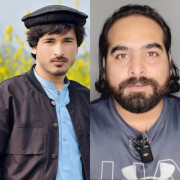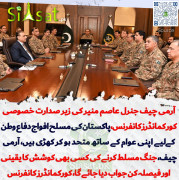Wadaich
Prime Minister (20k+ posts)
Balochistan area-wise is the biggest province of Pakistan, but having the smallest proportion of the population seem to be acquiring a focal position in the national and international media. The vast area does not only hold huge natural resources, but also has treasures of hidden secrets and stories of international interests that, unfortunately, result in the instability of the area and causes harm to the local population and their interests. The latest media reports converge on moulding ideas, building perceptions, and convincing people that the security apparatus is the main coercive tool being used against the natives to deprive them of their livelihood. The recent theme shows a similarity between the interested international partners and their facilitators at the local level. They blame the Pakistani media for not reporting on the brutal realities of Balochistan in any meaningful manner. Despite the fact that the province is of great strategic interest to the world, its people suffer from persistent, systemic and widespread human rights abuse by state authorities .The Human Rights Watch gives verdict by saying indisputable evidence points to the hand of the FC, the ISI and its sister agency, military intelligence, behind the killings and kidnapping. However, they fail to convince the general public on issues like the killings of 11 people by unidentified armed men at a Frontier Works Organisation (FWO) camp in Palari area of Balochistans Gwadar district, targeting settlers and government officials and killing at least 16 Punjabi speaking individuals in the Bolan area last August. The responsibility of all such incidents though has been publicly accepted by insurgent groups like BLA or BRA. They also do not bring out the armys contributions in Balochistan for a common Balochi. Especially General Kayanis announcements like the education city at Sui for the Balochi people and that Pakistan army will recruit 8,500 more youths from the province, while 4,000 Baloch youths have already joined the army after completing their training courses.Why the world focuses on Balochistan only? The answer lies in the vested interest of regional and global powers due to its geographical location. The covert hands supporting militancy, from within and through the safe havens provided to the militants in different countries seemed to be focused on the destabilisation of Pakistan. It is no secret now that the Government of Balochistan in exile (GOB Exile), established by the militants in April 2005, has its headquarter in Jerusalem, as is evident from the website that anyone can go and have a look. Very interestingly, the Balochistan Legal Fund (BLF) has the address originating from Washington DC. The ban on jihadi organisations and their assets freezing is a common international phenomenon, but what about such support originating from Washington? I am reminded of a document titled How Indias intelligence establishment see the Balochistan situation written by Kanchan Lakashman, which says: While the US is broadly committed to the general stabilisation of Pakistan, it does have a vested interest in delaying projects that would establish a dominant Chinese strategic presence in the region, particularly the Port of Gwadar. Thus, the military analyst predicts that some US interest will be persistent through low-grade violence in the province and this is where the Indo-US interest converges. According to the WikiLeaks, the Americans are also interested in increasing their influence in Gwadar and other part of the Balochistan. A regional think-tank says: Damaging China-Pakistan joint venture of development of Gwader port is one of the main US interest in Balochistan. The Gulf Times reported that the investigations into the Raymond Davis case, have revealed that the US spy agency CIA is indulging in heavy recruitment of local agents in Pakistans south-western province (Balochistan) to locate the members of the so-called Quetta-based Taliban Shura. The Quetta Shura is a term used by the Americans for the Mullah Omar-led Taliban commanders. The probe also indicates that around 300 plus CIA contractors are present in various parts of the country, apparently to keep an eye on the Taliban and Al-Qaeda leaders that the American suspects have taken refuge in various cities and towns across the country. According to a source: The New York Times reports that the Taliban commanders of Marja were killed in Quetta to give credibility to Quetta Shura, whereas the ISAF report confirms his death in action in Afghanistan. The pictures obtained from Raymond show the sensitive areas of the Pak-India border, which has more relevance for India, rather than America. Surely, the US is not the only player in the province. The activities of Mir Suleiman, Khan of Kalat operating from UK, holding anti-Pakistan rallies and submitting a letter to 10 Downing Street maligning Pakistan for forcible annexation of Balochistan has its own dimensions? What amazes one is the presence and involvement of the Indian Consulates in Afghanistan bordering Balochistan along the illegal arms supply route, the arrest of Mir Gazin Marri in Dubai in March 2006 for channelling funds to BLA, and the arrest and release of Harbayar Marri in UK - these facts leave many questions unanswered. Our political and military leaders often have information of this foreign hand, but they never speak.The most surprising move has this time come from India - its first initiative for cricket diplomacy to improve regional relationship. Such an initiative must be taken positively, but the future must be predicted in the light of history. India has always had a hegemonic approach towards its neighbours and its goodwill gestures have mostly concluded with economic or militarily strangulating projects for them. May it be, the construction of a barrage at Farakka, near the border with Bangladesh. For the downstream riparian country, freshwater availability depends on the share of water diverted by upstream India, and as a result Bangladesh has experienced a 50 percent decrease of dry season mean flow amounts, since the commissioning of the barrage in 1975. Such drastic reductions have caused a series of problems, including drop in agro and fish productivity, saltwater intrusion and ecological imbalance. Pakistan is locked in other territorial disputes with India such as the Siachen Glacier, Sir Creek and the construction of dams, including Baglihar Dam built over the River Chenab in Jammu and Kashmir. Similarly China, Nepal, Myanmar, and Sri Lanka all have host of problems with India, leading to mistrust in relationship. The cricket diplomacy had this time coupled with a report that India is all set to build 558 roads at a cost of Rs500 billion along the border with two hostile neighbours - China and Pakistan - in a bid to effectively counter the former, which is working at a high speed to execute a world class infrastructure along the Indo-China and Indo-Pakistan border region.This apart, the central government has also decided to build an all weather road along the 1,417 km long Indo-Myanmar border region, besides the construction of at least 50 helipads to ensure a quick reaction from the air force and the infantry, in case of any eventuality. India had redrafted its military doctrine on building border infrastructure along the Indo-China region, as the road and rail connectivity at the international border areas are now seen as a force multiplier in a real war situation, since they help faster movement of equipment and quick mobilisation of troops. This needs attention in the backdrop of the Indian military chiefs statement of taking both countries simultaneously through its Cold Start doctrine.Having said that, way forward and dialogue must get a chance and we should not only rely on history full of suspicions. There is a need to understand the latest foreign policy trends where America works with three faces - White House, Pentagon and CIA and India admits that pressure groups at times force its Prime Minister to pursue a particular policy line. Even in Pakistan, Zardari and Kayani have a line of action which is widely discussed. The answer lies in understanding, developing and cementing the house to guard implosions and securing national interest and pride at the international level.
Writer : Hamid Waheed
http://nation.com.pk/pakistan-news-.../Columns/27-Apr-2011/The-Balochistan-dynamics
Writer : Hamid Waheed
http://nation.com.pk/pakistan-news-.../Columns/27-Apr-2011/The-Balochistan-dynamics





























